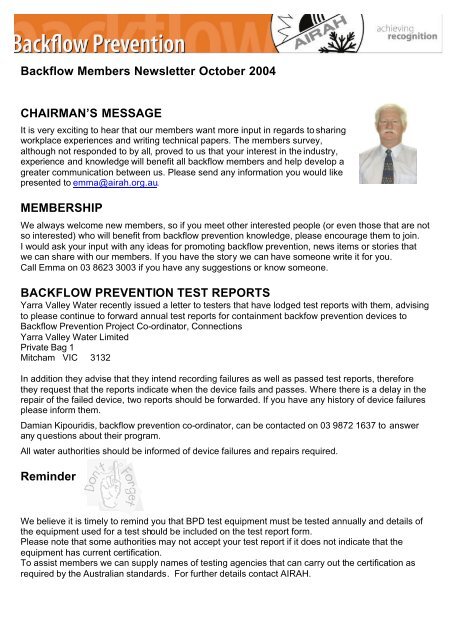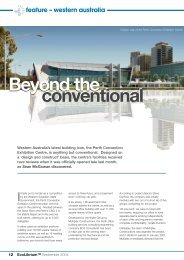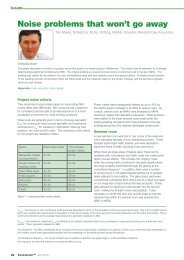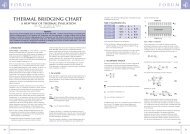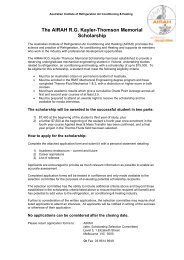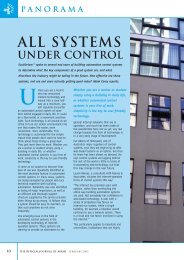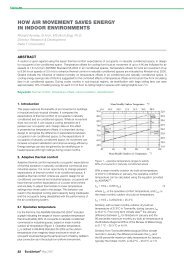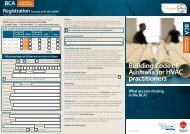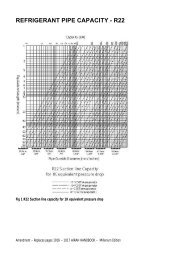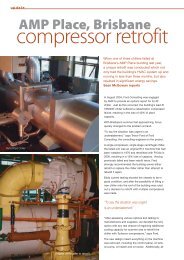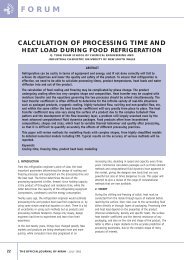BACKFLOW PREVENTION TEST REPORTS - Australian Institute of ...
BACKFLOW PREVENTION TEST REPORTS - Australian Institute of ...
BACKFLOW PREVENTION TEST REPORTS - Australian Institute of ...
You also want an ePaper? Increase the reach of your titles
YUMPU automatically turns print PDFs into web optimized ePapers that Google loves.
Backflow Members Newsletter October 2004<br />
CHAIRMAN’S MESSAGE<br />
It is very exciting to hear that our members want more input in regards to sharing<br />
workplace experiences and writing technical papers. The members survey,<br />
although not responded to by all, proved to us that your interest in the industry,<br />
experience and knowledge will benefit all backflow members and help develop a<br />
greater communication between us. Please send any information you would like<br />
presented to emma@airah.org.au.<br />
MEMBERSHIP<br />
We always welcome new members, so if you meet other interested people (or even those that are not<br />
so interested) who will benefit from backflow prevention knowledge, please encourage them to join.<br />
I would ask your input with any ideas for promoting backflow prevention, news items or stories that<br />
we can share with our members. If you have the story we can have someone write it for you.<br />
Call Emma on 03 8623 3003 if you have any suggestions or know someone.<br />
<strong>BACKFLOW</strong> <strong>PREVENTION</strong> <strong>TEST</strong> <strong>REPORTS</strong><br />
Yarra Valley Water recently issued a letter to testers that have lodged test reports with them, advising<br />
to please continue to forward annual test reports for containment backfow prevention devices to<br />
Backflow Prevention Project Co-ordinator, Connections<br />
Yarra Valley Water Limited<br />
Private Bag 1<br />
Mitcham VIC 3132<br />
In addition they advise that they intend recording failures as well as passed test reports, therefore<br />
they request that the reports indicate when the device fails and passes. Where there is a delay in the<br />
repair <strong>of</strong> the failed device, two reports should be forwarded. If you have any history <strong>of</strong> device failures<br />
please inform them.<br />
Damian Kipouridis, backflow prevention co-ordinator, can be contacted on 03 9872 1637 to answer<br />
any questions about their program.<br />
All water authorities should be informed <strong>of</strong> device failures and repairs required.<br />
Reminder<br />
We believe it is timely to remind you that BPD test equipment must be tested annually and details <strong>of</strong><br />
the equipment used for a test should be included on the test report form.<br />
Please note that some authorities may not accept your test report if it does not indicate that the<br />
equipment has current certification.<br />
To assist members we can supply names <strong>of</strong> testing agencies that can carry out the certification as<br />
required by the <strong>Australian</strong> standards. For further details contact AIRAH.
HOT NEWS<br />
Backflow Web Site<br />
The backflow prevention special interest group is now revamped and well worth a look at<br />
www.airah.org,au . You can also get there via www.bpaa.com.au<br />
Orders can be made online for backflow test tags, inspection booklets and other publications.<br />
New Plumbing Regulation<br />
The Victorian Government has recently passed through Parliament the Plumbing (Water and Energy<br />
Savings) Regulation 2004, Statutory Rule # 79/2004.<br />
These new regulations are in addition to the existing Plumbing Regulations 1998 Statutory Rule<br />
#148/1998 that call up <strong>Australian</strong>/New Zealand Standards AS/NZS 3500 – 2003, Plumbing and<br />
Drainage Code.<br />
The new regulations relate to:<br />
Water supply flow rates ( Limiting pressure to 500kpa)<br />
Rainwater tanks<br />
Solar water heaters<br />
These sections have reference to the use <strong>of</strong> backflow prevention devices and therefore all members<br />
should obtain a copy from Information Victoria.<br />
To obtain your copy contact Information Victoria ( 356 Collins Street, Melbourne)<br />
1300 366 356 or by fax 03 9603 9920.<br />
Plumbing and Mechanical Connection<br />
The spring quarter September 2004 magazine has several articles on backflow prevention. Of<br />
particular note is the one by member John Mulvey titled Backflow the risk is there.<br />
It is well worth a read as he provides several examples <strong>of</strong> cross connections and incidents that have<br />
been very serious.<br />
FEEDBACK WANTED<br />
Currently Yarra Valley Water is issuing annual test notices with the due test date as the date <strong>of</strong> first<br />
test, even if the device was tested on a different date previously.<br />
Is this a problem for members?<br />
A member has raised this issue as a problem, what is your view?<br />
FIRE SERVICES AND <strong>BACKFLOW</strong> <strong>PREVENTION</strong><br />
This year one Melbourne water company has had two incidents where repairs to a burst water main<br />
were prevented as the flow <strong>of</strong> water in the pipe did not stop. This was due to the nearby factory<br />
having fire services that provide alternate supply and the old non-return valves not shutting <strong>of</strong>f. Water<br />
was able to flow from the adjoining street’s water main through the fire service to the burst. The water<br />
company staff checked valves and the adjoining properties services to try and stop the flow <strong>of</strong> water.<br />
If the valves were serviced regularly or replaced with backflow prevention devices then such incidents<br />
would not occur. The two companies have been directed by the water company to upgrade the valves<br />
in accordance with AS/NZS 3500. 1:2003.
JUST FOR FUN!<br />
A Day Off!!!<br />
A 1 st year apprentice asks his boss, Mr Plumb-Right for a day <strong>of</strong>f.<br />
“So you want a day <strong>of</strong>f. Let’s take a look at what you are asking for: There are 365 days per year<br />
available for work. There are 52 weeks per year in which you already have two days <strong>of</strong>f per week,<br />
leaving 261 days available for work.<br />
Since you spend 16 hours each day away from work, you have used up 170 days, leaving only 91<br />
days available. You spend 30 minutes each day on c<strong>of</strong>fee break which counts for 23 days each year,<br />
leaving only 68 days available. With a one hour lunch each day, you used up another 46 days,<br />
leaving only 22 days available for work.<br />
You normally spend two days per year on sick leave. This leaves you only 20 days per year available<br />
for work. We are <strong>of</strong>f five holidays per year, so your available working time is down to 15 days. We<br />
generously give 14 days vacation per year which leaves only one day available for work and I’ll be<br />
damned if you are going to take that <strong>of</strong>f!<br />
Marine and Freshwater Resources <strong>Institute</strong> Site Visit Report<br />
On September 30 th , AIRAH Geelong organised a site visit to the new Marine and Freshwater<br />
Resources <strong>Institute</strong> facility in Queenscliff. The visit was open to all AIRAH members, including the<br />
Backflow special interest group. The MAFRI facility has been constructed over the past 18 months<br />
and is programmed to be fully operational in late November this year. The tour was hosted by Mr<br />
John Barry, facilities manager, South West Region Department <strong>of</strong> Primary Industries.<br />
It was a fascinating tour. The building has been designed to be ecologically friendly and the facility<br />
includes many innovative and specialised features.<br />
For example, all <strong>of</strong> the timber panels and flooring are made from recycled materials. There is also a<br />
soil/grass and crushed rock ro<strong>of</strong>, with the ro<strong>of</strong> water used for the fire / irrigation water combo tank<br />
(they assured me there was a proper air gap for backflow prevention).<br />
Internally the building has natural ventilation and a hydronic heating system.<br />
One <strong>of</strong> the highlights <strong>of</strong> the tour was the seawater pumping system, which included two 150mm pipes<br />
(with direct digital control) horizontally bored for 750 metres into the bay. The seawater is filtered and<br />
pumped into tanks ready for distribution into the numerous laboratories around the facility.<br />
There were many other systems, including seawater electric heat pumps, air cooled chillers, boilers,<br />
constant temperature rooms, fume cupboards and various different types <strong>of</strong> water systems for marine<br />
and freshwater studies.<br />
I would like to thank AIRAH Geelong for organising this most interesting tour, and I would urge all<br />
backflow prevention members to keep their eyes open for any future site tours organised by AIRAH.<br />
Jeff Parsonage
American Backflow Prevention<br />
As more recycled water systems are implemented across Australia this incident is a timely reminder<br />
that plumbers and water companies should remain diligent and follow correct procedures.<br />
A recent recycled water incident<br />
Another example <strong>of</strong> a recycled water service being connected to the potable water service at four<br />
properties in Cape Coral, Lee County has been widely reported by a number <strong>of</strong> media outlets.<br />
The city’s water and sewerage company became aware <strong>of</strong> the problem after complaints from several<br />
families were received in July 2003 regarding the pressure and taste <strong>of</strong> the water. The water is<br />
supplied to the neighbourhood for irrigation purposes only, but one <strong>of</strong> the families had been using it<br />
for three months.<br />
The city’s contractors failed to dig deep enough to establish which pipe was the correct one to<br />
connect to, identified by tape laid with the pipe during installation.<br />
According to the local health authority, although the irrigation water is filtered and treated with<br />
chlorine, it is not permitted for drinking and can cause gastrointestinal problems, such as vomiting<br />
and diarrhoea.<br />
A thorough examination <strong>of</strong> the 580 properties covered by this recycled system was carried out and<br />
only the original four properties where the owners complained where identified. The City <strong>of</strong> Cape<br />
Coral was required to spend many hours and US $72,000 fixing the error.<br />
New frontiers in rainwater harvesting<br />
Davey Products has unveiled “an innovative new product in household water saving” – RainBank ® .<br />
According to the company, RainBank ® is the first water harvesting product to automatically switch<br />
between rainwater and mains water supply. A dual-check valve is used to ensure backflow<br />
prevention - a novel development in plumbing. Davey Products cites water saving benefits <strong>of</strong> up to<br />
40%, which it believes will be popular with builders seeking approval for new designs under BASIX in<br />
New South Wales and 5 Star in Victoria.<br />
The company states that the unit is ideal for installation alongside existing water mains supply<br />
systems as an upgrade. Alternatively, the RainBank ® can be installed as an addition to any water<br />
system built into new structures.<br />
Minimal energy is required for the device, as it does not require mains water to be repressurised and<br />
uses no energy even in stand-by mode. The unit is an automatic means <strong>of</strong> providing water stores for<br />
the toilet and laundry when supplies are available. If water supplies are low or in the case <strong>of</strong> power<br />
failure the unit reverts automatically to the mains supply.<br />
Developments have also been made with the standards regulating the product and others like it. Until<br />
recently, standards on combining rain and mains water were set by each state individually, inevitably<br />
resulting in some confusion. A revised, nationally consistent code <strong>of</strong> practice, ‘The Plumbing Code <strong>of</strong><br />
Australia’, has now been issued by the Victorian Plumbing Industry Commision and is being reviewed<br />
by state governments. This is expected to make metropolitan harvesting <strong>of</strong> rainwater more popular<br />
and accessible.
The units have been certified to adhere to AS/NZ3500.1.2003 Plumbing and drainage, ATS 5200.466<br />
Technical specification for plumbing and drainage products and AS4020 Testing <strong>of</strong> products for use<br />
in contact with drinking water, and have received Water Mark approval with licence IPC 20009.<br />
For more information, visit www.davey.com.au/rainbank
Please fax this form to back to AIRAH on 9614 8949<br />
Name: ...........................................................<br />
Company: .....................................................<br />
Address:.......................................................<br />
......................................................................<br />
......................................................................<br />
Phone: ..........................................................<br />
Fax:...............................................................<br />
Email:............................................................<br />
1. Would you like to participate in our special interest group<br />
(backflow) meetings yes no<br />
2. Are you interested in attending an end <strong>of</strong> year backflow<br />
Dinner with a guest speaker yes no<br />
3. Are you interested in becoming a backflow committee<br />
member yes no


